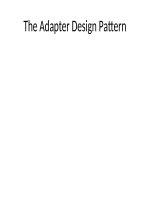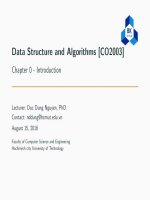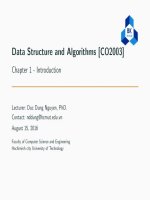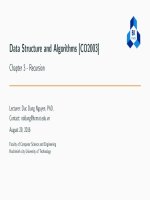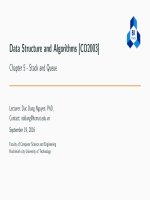C++ programming program design including data structure 7th ch01
Bạn đang xem bản rút gọn của tài liệu. Xem và tải ngay bản đầy đủ của tài liệu tại đây (244.19 KB, 48 trang )
Chapter 1:
An Overview of Computers and
Programming Languages
Objectives
•
In this chapter, you will:
– Learn about different types of computers
– Explore the hardware and software components of a computer system
– Learn about the language of a computer
– Learn about the evolution of programming languages
– Examine high-level programming languages
C++ Programming: Program Design Including Data Structures, Seventh Edition
2
Objectives (cont’d.)
– Discover what a compiler is and what it does
– Examine a C++ program
– Explore how a C++ program is processed
– Learn what an algorithm is and explore problem-solving techniques
– Become aware of structured design and object-oriented design
programming methodologies
– Become aware of Standard C++, ANSI/ISO Standard C++, and C++11
C++ Programming: Program Design Including Data Structures, Seventh Edition
3
Introduction
•
Without software, the computer is useless
•
Software is developed with programming languages
– C++ is a programming language
•
C++ suited for a wide variety of programming tasks
C++ Programming: Program Design Including Data Structures, Seventh Edition
4
A Brief Overview of the History of
Computers
•
Early calculation devices
– Abacus, Pascaline
– Leibniz device
– Jacquard’s weaving looms
– Babbage machines: difference and analytic engines
– Hollerith machine
C++ Programming: Program Design Including Data Structures, Seventh Edition
5
A Brief Overview of the History of
Computers (cont’d.)
•
Early computer-like machines
– Mark I
– ENIAC
– Von Neumann architecture
– UNIVAC
– Transistors and microprocessors
C++ Programming: Program Design Including Data Structures, Seventh Edition
6
A Brief Overview of the History of
Computers (cont’d.)
•
Categories of computers
– Mainframe computers
– Midsize computers
– Micro computers (personal computers)
C++ Programming: Program Design Including Data Structures, Seventh Edition
7
Elements of a Computer System
•
Hardware
•
CPU
•
Main memory
•
Secondary storage
•
Input/Output devices
•
Software
C++ Programming: Program Design Including Data Structures, Seventh Edition
8
Hardware
•
CPU
•
Main memory: RAM
•
Input/output devices
•
Secondary storage
C++ Programming: Program Design Including Data Structures, Seventh Edition
9
Central Processing Unit and Main
Memory
•
Central processing unit
– Brain of the computer
– Most expensive piece of hardware
– Carries out arithmetic and logical operations
C++ Programming: Program Design Including Data Structures, Seventh Edition
10
Central Processing Unit and Main
Memory (cont’d.)
C++ Programming: Program Design Including Data Structures, Seventh Edition
11
Central Processing Unit and Main
Memory (cont’d.)
•
Random access memory
– Directly connected to the CPU
•
All programs must be loaded into main memory before they can be executed
•
All data must be brought into main memory before it can be manipulated
•
When computer power is turned off, everything in main memory is lost
C++ Programming: Program Design Including Data Structures, Seventh Edition
12
Central Processing Unit and Main
Memory (cont’d.)
•
Main memory is an ordered sequence of memory cells
– Each cell has a unique location in main memory, called the address of
the cell
•
Each cell can contain either a programming instruction or data
C++ Programming: Program Design Including Data Structures, Seventh Edition
13
Secondary Storage
•
Secondary storage: device that stores information permanently
•
Examples of secondary storage:
– Hard disks
– Flash drives
– Floppy disks
– Zip disks
– CD-ROMs
– Tapes
C++ Programming: Program Design Including Data Structures, Seventh Edition
14
Input/Output Devices
•
Input devices feed data and programs into computers
– Keyboard
– Mouse
– Secondary storage
•
Output devices display results
– Monitor
– Printer
– Secondary storage
C++ Programming: Program Design Including Data Structures, Seventh Edition
15
Software
• Software: programs that do specific tasks
• System programs control the computer
– Operating system monitors the overall activity of the
computer and provides services such as:
• Memory management
• Input/output activities
• Storage management
• Application programs perform a specific task
– Word processors
– Spreadsheets
– Games
C++ Programming: Program Design Including Data Structures, Seventh Edition
16
The Language of a Computer
•
Analog signals: continuous wave forms
•
Digital signals: sequences of 0s and 1s
•
Machine language: language of a computer; a sequence of 0s and 1s
•
Binary digit (bit): the digit 0 or 1
•
Binary code (binary number): a sequence of 0s
and 1s
C++ Programming: Program Design Including Data Structures, Seventh Edition
17
The Language of a Computer (cont’d.)
•
Byte:
– A sequence of eight bits
•
Kilobyte (KB): 210 bytes = 1024 bytes
•
ASCII (American Standard Code for Information Interchange)
– 128 characters
– A is encoded as 1000001 (66th character)
– 3 is encoded as 0110011
C++ Programming: Program Design Including Data Structures, Seventh Edition
18
The Language of a Computer (cont’d.)
C++ Programming: Program Design Including Data Structures, Seventh Edition
19
The Language of a Computer (cont’d.)
•
EBCDIC
– Used by IBM
– 256 characters
•
Unicode
– 65536 characters
– Two bytes are needed to store a character
C++ Programming: Program Design Including Data Structures, Seventh Edition
20
The Evolution of Programming
Languages
•
Early computers were programmed in machine language
•
To calculate wages = rate * hours in machine language:
100100 010001
//Load
100110 010010
//Multiply
100010 010011
//Store
C++ Programming: Program Design Including Data Structures, Seventh Edition
21
The Evolution of Programming
Languages (cont’d.)
•
Assembly language instructions are mnemonic
•
Assembler: translates a program written in assembly language into machine language
•
Using assembly language instructions, wages = rate • hours can be written as:
LOAD
rate
MULT
hour
STOR
wages
C++ Programming: Program Design Including Data Structures, Seventh Edition
22
The Evolution of Programming
Languages (cont’d.)
•
High-level languages include Basic, FORTRAN, COBOL, Pascal, C, C++, C#, and Java
•
Compiler: translates a program written in a high-level language into machine language
•
The equation wages = rate • hours can be written in C++ as:
wages = rate * hours;
C++ Programming: Program Design Including Data Structures, Seventh Edition
23
Processing a C++ Program
#include <iostream>
using namespace std;
int main()
{
cout << "My first C++ program." << endl;
return 0;
}
Sample Run:
My first C++ program.
C++ Programming: Program Design Including Data Structures, Seventh Edition
24
Processing a C++ Program (cont’d.)
•
To execute a C++ program:
– Use an editor to create a source program in C++
– Preprocessor directives begin with # and are processed by the
preprocessor
– Use the compiler to:
• Check that the program obeys the language rules
• Translate into machine language (object program)
C++ Programming: Program Design Including Data Structures, Seventh Edition
25

